A Small-Scale Landslide in 2023, Leshan, China: Basic Characteristics, Kinematic Process and Cause Analysis
Abstract
1. Introduction
2. Overview of the Landslide Area
3. Data and Methods
3.1. Data
3.2. Methods
3.2.1. Methods for Analyzing Pre-Landslide Deformation
- Interferogram Baseline Combination: The Sentinel-1A data, which had been clipped, was processed using SARscape 5.2 software in ENVI to perform interferometric filtering. A total of 101 image pairs were generated, with the temporal and spatial baseline thresholds set at 75 d and 5%, respectively.
- Interferometric Workflow: The entire process includes coherence generation, interferogram flattening, filtering (using the Goldstein filtering method to enhance filtering), and phase unwrapping (using the minimum cost flow method). By setting the multi-look number to 1:4, speckle noise can be effectively suppressed. Setting the unwrapping grade to 2 and the unwrapping threshold to 0.29 ensures sufficient unwrapped data in mountainous areas, thereby removing some noise and reducing data storage requirements.
- Orbit Refinement and Reflattening: Given the complex terrain and numerous mountains in the study area, Google Earth was used to select stable points, such as stable transportation hubs and other structures, as ground control points (GCP) to reduce errors caused by improper point selection.
- SBAS Inversion: This includes estimating deformation rates and residual topography based on the thresholds of the first inversion and optimizing the unwrapped map generated in the second step for subsequent processing.
- Geocoding: By unifying the geographical coordinates of the results from the two inversions, an annual average deformation rate map of the deformation points in the study area was obtained.
3.2.2. Methods for Kinematic Analysis of Landslides
4. Results
4.1. Basic Characteristics of the Landslide
4.2. Characteristics of Pre-Landslide Deformation
4.2.1. Analysis of Historical Imagery before Landslides
4.2.2. Analysis of Pre-Landslide Surface InSAR Deformation
4.3. Kinematic Process of the Landslide
4.3.1. Analysis of Landslide Accumulation Range and Stages
4.3.2. Analysis of Landslide Movement Velocity and Stages
5. Discussion
5.1. Causes of the Landslide
5.2. Simulation Accuracy Analysis
6. Conclusions
Author Contributions
Funding
Data Availability Statement
Conflicts of Interest
References
- Zhao, C.; Lu, Z. Remote Sensing of Landslides—A Review. Remote Sens. 2018, 10, 279. [Google Scholar] [CrossRef]
- Dai, F.; Lee, C.; Wang, S. Characterization of rainfall-induced landslides. Int. J. Remote Sens. 2003, 24, 4817–4834. [Google Scholar] [CrossRef]
- Fan, L.; Lehmann, P.; Mcardell, B.; Or, D. Linking rainfall-induced landslides with debris flows runout patterns towards catchment scale hazard assessment. Geomorphology 2017, 280, 1–15. [Google Scholar] [CrossRef]
- Li, Y.; Ma, C.; Wang, Y. Landslides and debris flows caused by an extreme rainstorm on 21 July 2012 in mountains near Beijing, China. Bull. Eng. Geol. Environ. 2019, 78, 1265–1280. [Google Scholar] [CrossRef]
- Yin, Y.; Zheng, W.; Li, X.; Sun, P.; Li, B. Catastrophic landslides associated with the M8. 0 Wenchuan earthquake. Bull. Eng. Geol. Environ. 2011, 70, 15–32. [Google Scholar] [CrossRef]
- Shrestha, S.; Kang, T. Assessment of seismically-induced landslide susceptibility after the 2015 Gorkha earthquake, Nepal. Bull. Eng. Geol. Environ. 2019, 78, 1829–1842. [Google Scholar] [CrossRef]
- Lin, C.; Chang, W.; Liu, S.; Tsai, T.; Lee, S.; Tsang, Y.; Shieh, C.; Tseng, C. Landslides triggered by the 7 August 2009 Typhoon Morakot in southern Taiwan. Eng. Geol. 2011, 123, 3–12. [Google Scholar] [CrossRef]
- Bhardwaj, A.; Wasson, R.; Ziegler, A.; Ziegler, A.; Chow, W.; Sundriyal, Y. Characteristics of rain-induced landslides in the Indian Himalaya: A case study of the Mandakini Catchment during the 2013 flood. Geomorphology 2019, 330, 100–115. [Google Scholar] [CrossRef]
- Bezak, N.; Jež, J.; Sodnik, J.; Jemec, A.; Mikoš, M. An extreme May 2018 debris flood case study in northern Slovenia: Analysis, modelling, and mitigation. Landslides 2020, 17, 2373–2383. [Google Scholar] [CrossRef]
- Kotlyakov, V.; Rototaeva, O.; Nosenko, G. The September 2002 Kolka glacier catastrophe in North Ossetia, Russian Federation: Evidence and analysis. Mt. Res. Dev. 2004, 24, 78–83. [Google Scholar] [CrossRef]
- Ma, P.; Peng, J.; Wang, Q.; Zhuang, J.; Zhang, F. The mechanisms of a loess landslide triggered by diversion-based irrigation: A case study of the South Jingyang Platform, China. Bull. Eng. Geol. Environ. 2019, 78, 4945–4963. [Google Scholar] [CrossRef]
- Cui, Y.; Xu, C.; Xu, S.; Chai, S.; Fu, G.; Bao, P. Small-scale catastrophic landslides in loess areas of China: An example of the March 15, 2019, Zaoling landslide in Shanxi Province. Landslides 2020, 17, 669–676. [Google Scholar] [CrossRef]
- Zhang, F.; Liu, G.; Chen, W.; Liang, S.; Chen, R.; Han, W. Human-induced landslide on a high cut slope: A case of repeated failures due to multi-excavation. J. Rock Mech. Geotech. Eng. 2012, 4, 367–374. [Google Scholar] [CrossRef]
- Zhuang, Y.; Xing, A.; Jiang, Y.; Sun, Q.; Yan, J.; Zhang, Y. Typhoon, rainfall and trees jointly cause landslides in coastal regions. Eng. Geol. 2022, 298, 106561. [Google Scholar] [CrossRef]
- Cui, Y.; Hu, J.; Xu, C.; Zheng, J.; Wei, J. A catastrophic natural disaster chain of typhoon-rainstorm-landslide-barrier lake-flooding in Zhejiang Province, China. J. Mt. Sci. 2021, 18, 2108–2119. [Google Scholar] [CrossRef]
- Yin, Y. Recent catastrophic landslides and mitigation in China. J. Rock Mech. Geotech. Eng. 2011, 3, 10–18. [Google Scholar] [CrossRef]
- Lin, Q.; Wang, Y. Spatial and temporal analysis of a fatal landslide inventory in China from 1950 to 2016. Landslides 2018, 15, 2357–2372. [Google Scholar] [CrossRef]
- Poisel, R.; Preh, A.; Hungr, O. Run out of landslides–continuum mechanics versus discontinuum mechanics models. Geomech. Tunnelbau 2008, 1, 358–366. [Google Scholar] [CrossRef]
- Roslan, R.; Omar, R.; Putri, R.; Wahab, W.; Baharuddin, I.; Jaafar, R. Slope stability analysis using Universal Distinct Element Code (UDEC) method. IOP Conf. Ser. Earth Environ. Sci. 2020, 451, 012081. [Google Scholar] [CrossRef]
- Filice, F.; Pezzo, A.; Lollino, P.; Perrotti, M.; Ietto, F. Multi-approach for the assessment of rock slope stability using in-field and UAV investigations. Bull. Eng. Geol. Environ. 2022, 81, 502. [Google Scholar] [CrossRef]
- Schilirò, L.; Massaro, L.; Forte, G.; Santo, A.; Tommasi, P. Analysis of Earthquake-Triggered Landslides through an Integrated Unmanned Aerial Vehicle-Based Approach: A Case Study from Central Italy. Remote Sens. 2024, 16, 93. [Google Scholar] [CrossRef]
- Niethammer, U.; James, M.; Rothmund, S.; Travelletti, J.; Joswig, M. UAV-based remote sensing of the Super-Sauze landslide: Evaluation and results. Eng. Geol. 2012, 128, 2–11. [Google Scholar] [CrossRef]
- Massaro, L.; Forte, G.; De Falco, M.; Rauseo, F.; Santo, A. Rockfall source identification and trajectory analysis from UAV-based data in volcano-tectonic areas: A case study from Ischia Island, Southern Italy. Bull. Eng. Geol. Environ. 2024, 83, 75. [Google Scholar] [CrossRef]
- Ouyang, C.; Zhou, K.; Xu, Q.; Yin, J.; Peng, D.; Wang, D.; Li, W. Dynamic analysis and numerical modeling of the 2015 catastrophic landslide of the construction waste landfill at Guangming, Shenzhen, China. Landslides 2017, 14, 705–718. [Google Scholar] [CrossRef]
- Scaringi, G.; Fan, X.; Xu, Q.; Liu, C.; Ouyang, C.; Domènech, G.; Yang, F.; Dai, L. Some considerations on the use of numerical methods to simulate past landslides and possible new failures: The case of the recent Xinmo landslide (Sichuan, China). Landslides 2018, 15, 1359–1375. [Google Scholar] [CrossRef]
- Fan, X.; Yang, F.; Siva, S.; Xu, Q.; Feng, Z.; Mavrouli, O.; Peng, M.; Ouyang, C.; Jansen, J.; Huang, R. Prediction of a multi-hazard chain by an integrated numerical simulation approach: The Baige landslide, Jinsha River, China. Landslides 2020, 17, 147–164. [Google Scholar] [CrossRef]
- Ouyang, C.; He, S.; Xu, Q.; Luo, Y.; Zhang, W. A MacCormack-TVD finite difference method to simulate the mass flow in mountainous terrain with variable computational domain. Comput. Geosci. 2013, 52, 1–10. [Google Scholar] [CrossRef]
- Zhao, C.; Kang, Y.; Zhang, Q.; Lu, Z.; Li, B. Landslide Identification and Monitoring along the Jinsha River Catchment (Wudongde Reservoir Area), China, Using the InSAR Method. Remote Sens. 2018, 10, 993. [Google Scholar] [CrossRef]
- Ouyang, C.; He, S.; Xu, Q. MacCormack-TVD finite difference solution for dam break hydraulics over erodible sediment beds. J. Hydraul. Eng. 2015, 141, 06014026. [Google Scholar] [CrossRef]
- Ching, J.; Schweckendiek, T. State-of-the-art review of inherent variability and uncertainty in geotechnical properties and models. ISSMGE Tech. Comm. 2021, 304, 219. Available online: http://140.112.12.21/issmge/2021/SOA_Review_on_geotechnical_property_variablity_and_model_uncertainty.pdf (accessed on 2 August 2024).
- Chu, H.; Sun, C.; Zhang, X.; Li, C. Research on engineering geology characteristics of Wangshan-Zhuakousi landslide in sliding zone in Emeishan city. Chin. J. Geol. Hazard Control 2017, 28, 48–52. [Google Scholar] [CrossRef]
- Chen, X.; Zhao, Z.; Wei, J.; Xu, C. Numerical study of Mabian landslide kinematics and impact intensity. Coal Geol. Explor. 2021, 49, 234–241. [Google Scholar] [CrossRef]
- Godt, J.; Baum, R.; Chleborad, A. Rainfall characteristics for shallow landsliding in Seattle, Washington, USA. Earth Surf. Process. Landf. J. Br. Geomorphol. Res. Group 2006, 31, 97–110. [Google Scholar] [CrossRef]
- Chigira, M. September 2005 rain-induced catastrophic rockslides on slopes affected by deep-seated gravitational deformations, Kyushu, southern Japan. Eng. Geol. 2009, 108, 1–15. [Google Scholar] [CrossRef]
- Evans, S.; Guthrie, R.; Roberts, N.; Bishop, N. The disastrous 17 February 2006 rockslide-debris avalanche on Leyte Island, Philippines: A catastrophic landslide in tropical mountain terrain. Nat. Hazards Earth Syst. Sci. 2007, 7, 89–101. [Google Scholar] [CrossRef]
- De Falco, M.; Forte, G.; Marino, E.; Massaro, L.; Santo, A. UAV and field survey observations on the November 26th 2022 Celario flowslide, Ischia Island (Southern Italy). J. Maps 2023, 19, 2261484. [Google Scholar] [CrossRef]
- Zhou, Q.; Xu, Q.; Zhou, X.; Zhao, K.; Xiu, D.; Peng, D. Research on the predicting hazard range of abrupt loess landslide—A case study of jj6 # landslide in Heifangtai tableland. J. Catastrophol. 2020, 35, 216–221. [Google Scholar] [CrossRef]
- Elias, E.; Walstra, D.; Roelvink, J.; Stive, M.; Klein, M. Hydrodynamic validation of Delft3D with field measurements at Egmond. Coast. Eng. 2001, 2000, 2714–2727. [Google Scholar] [CrossRef]
- Villaret, C.; Hervouet, J.; Kopmann, R.; Merkel, U.; Davies, A. Morphodynamic modeling using the Telemac finite-element system. Comput. Geosci. 2013, 53, 105–113. [Google Scholar] [CrossRef]
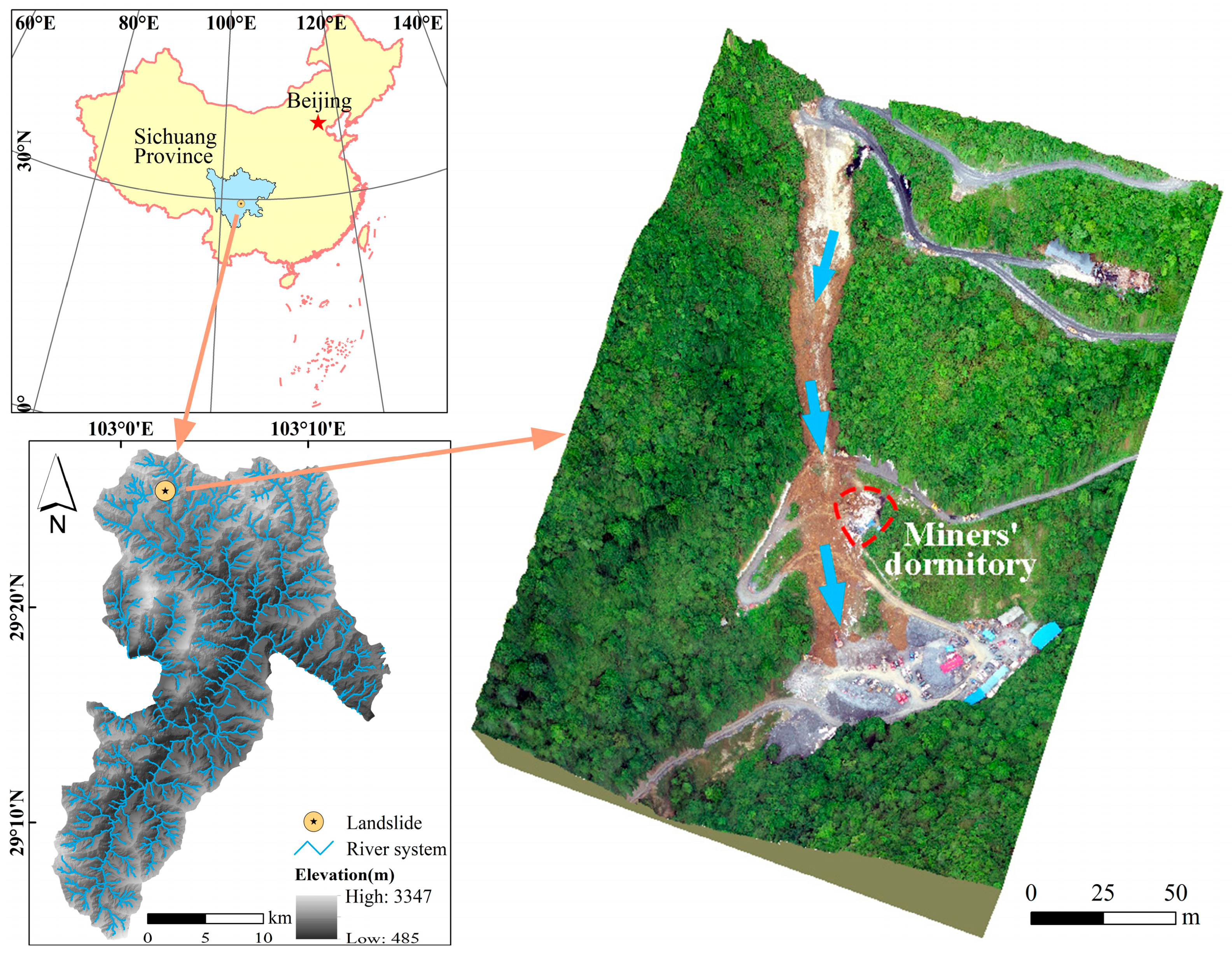
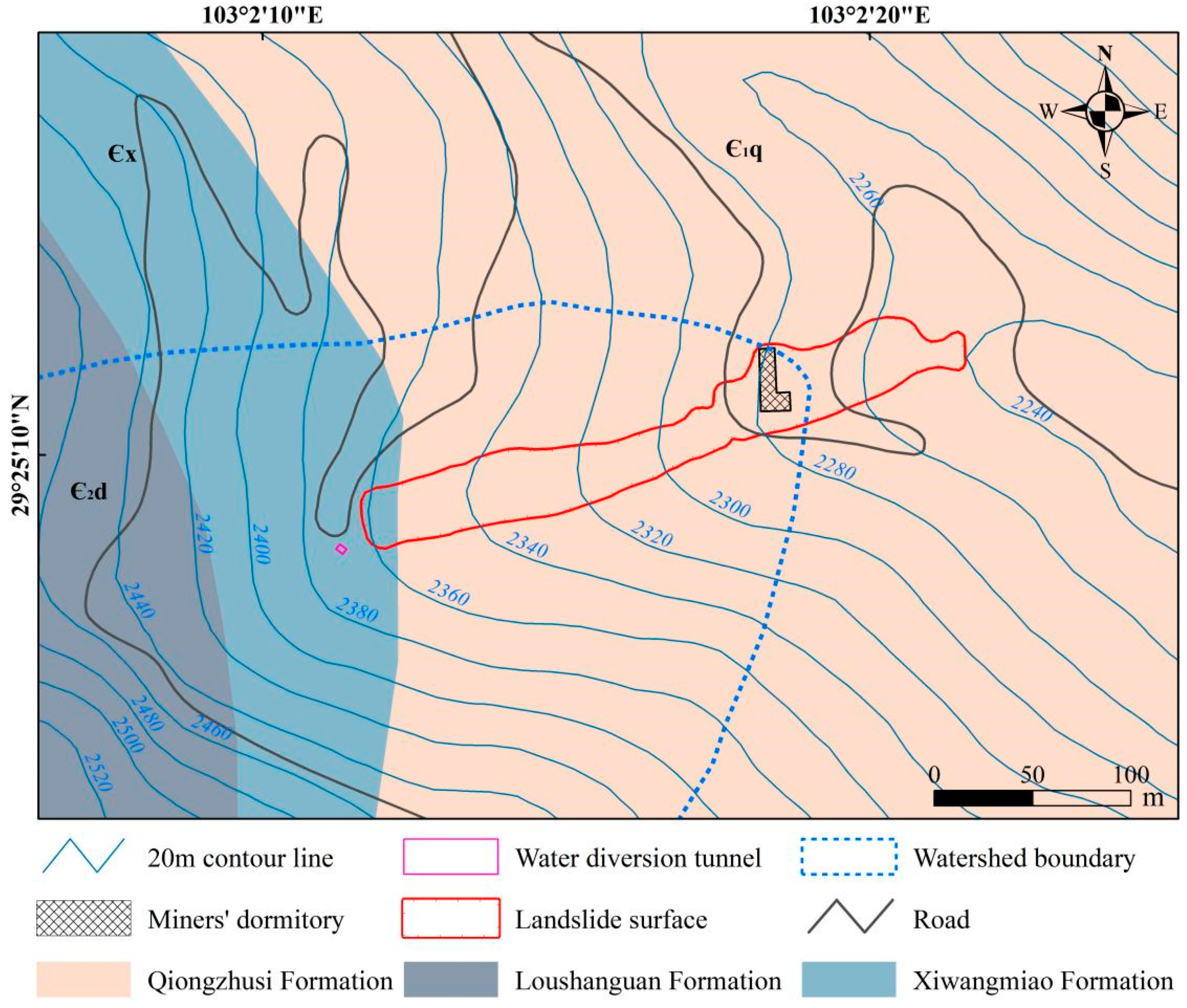

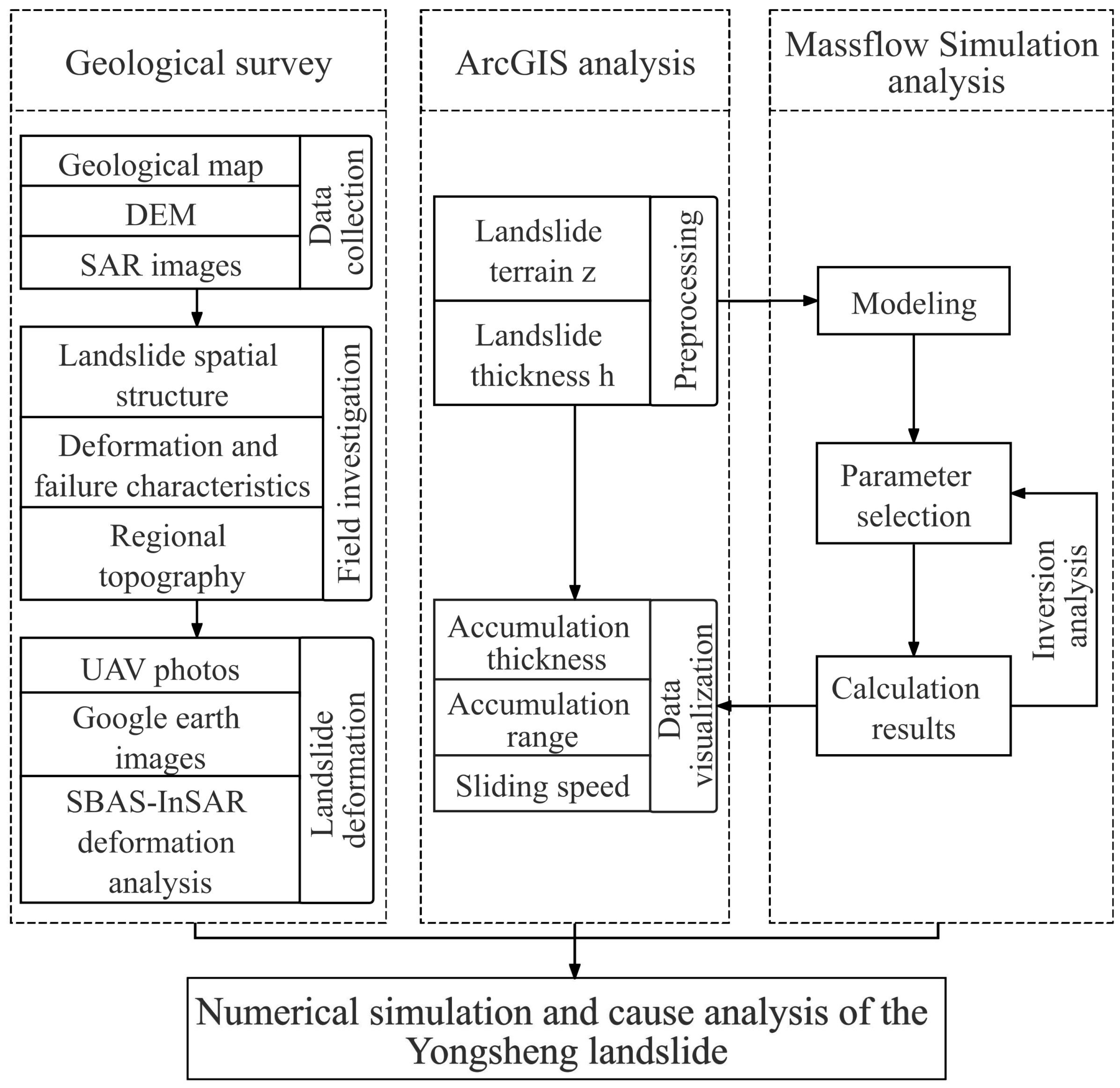
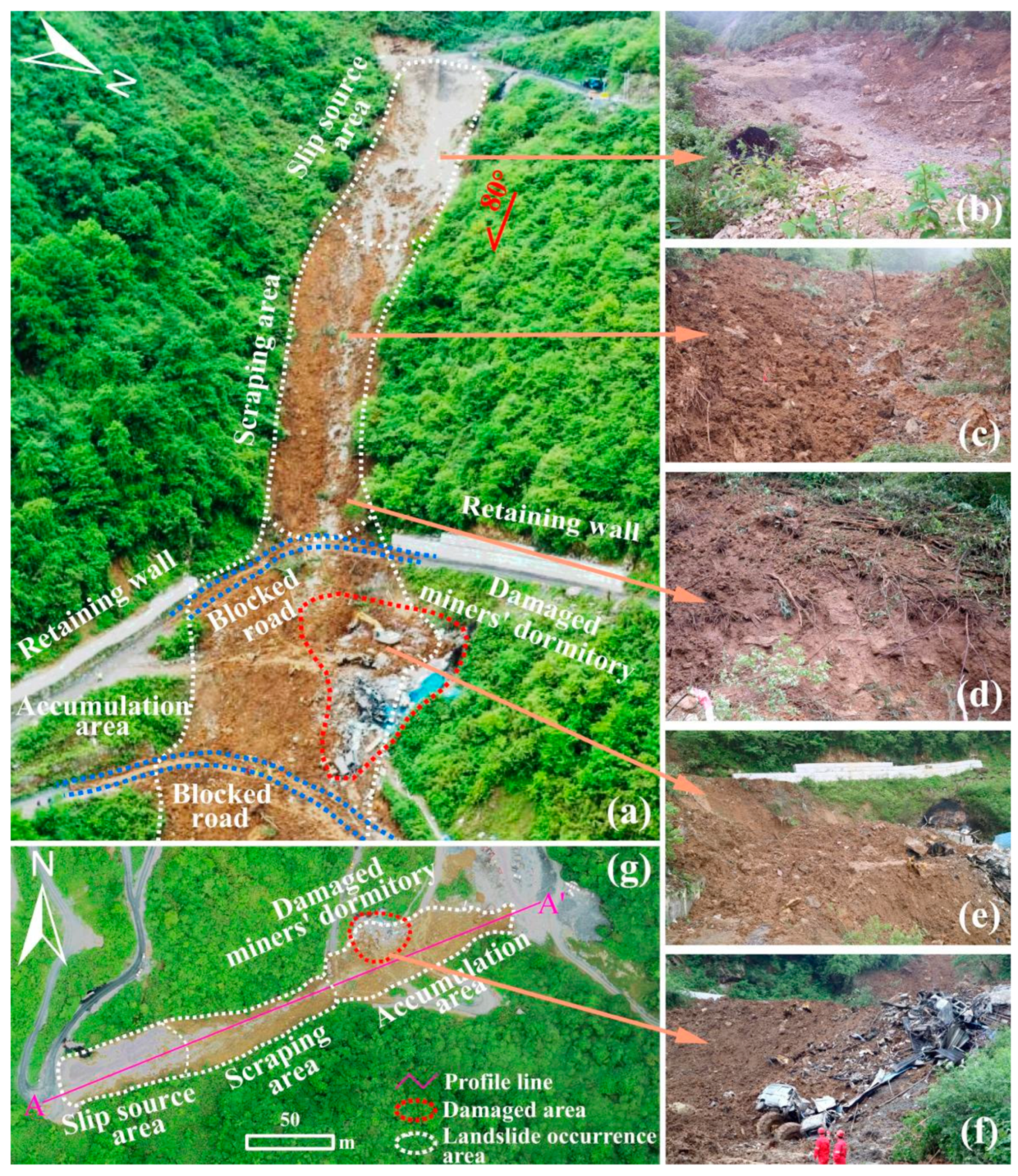


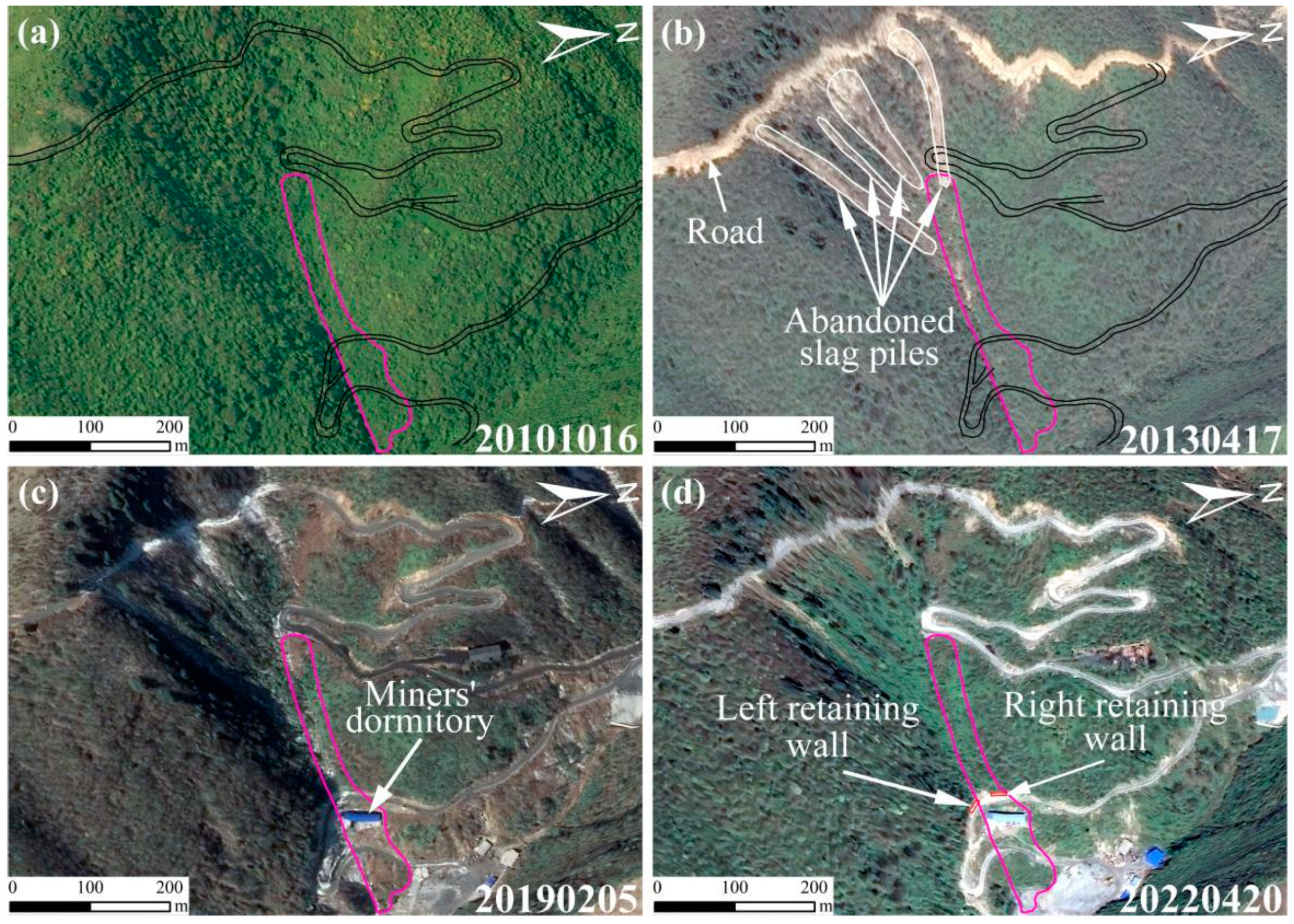
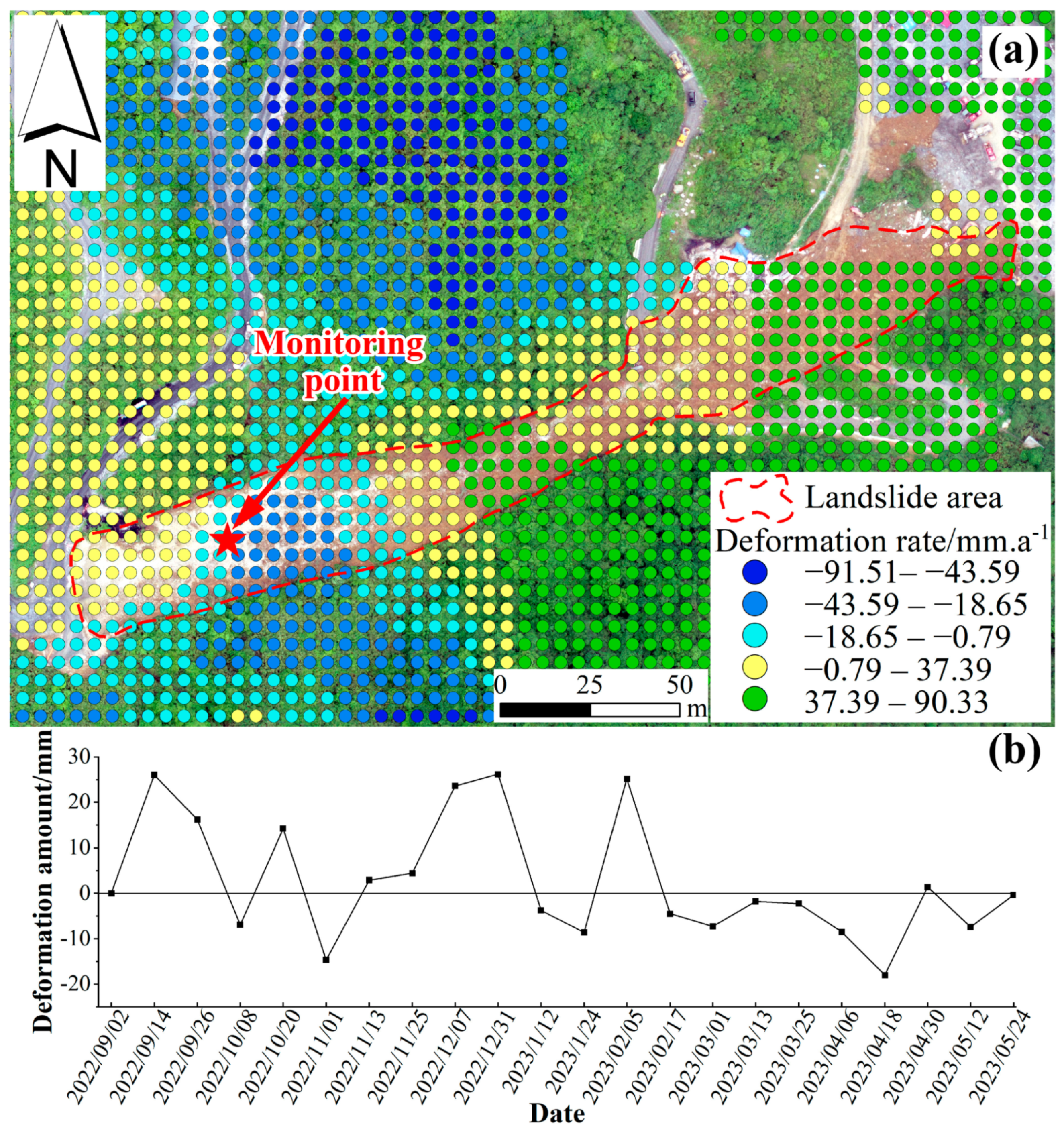
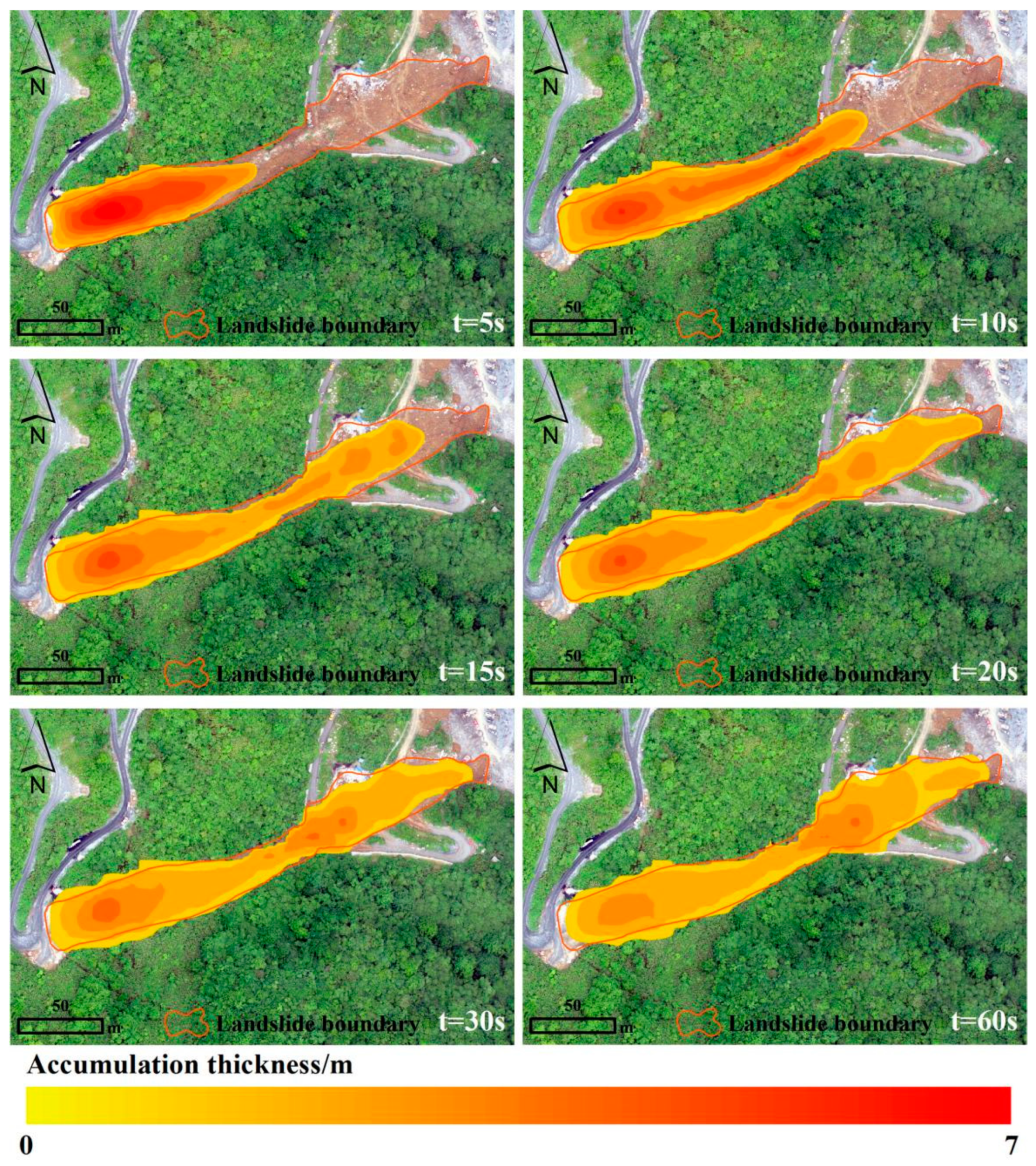
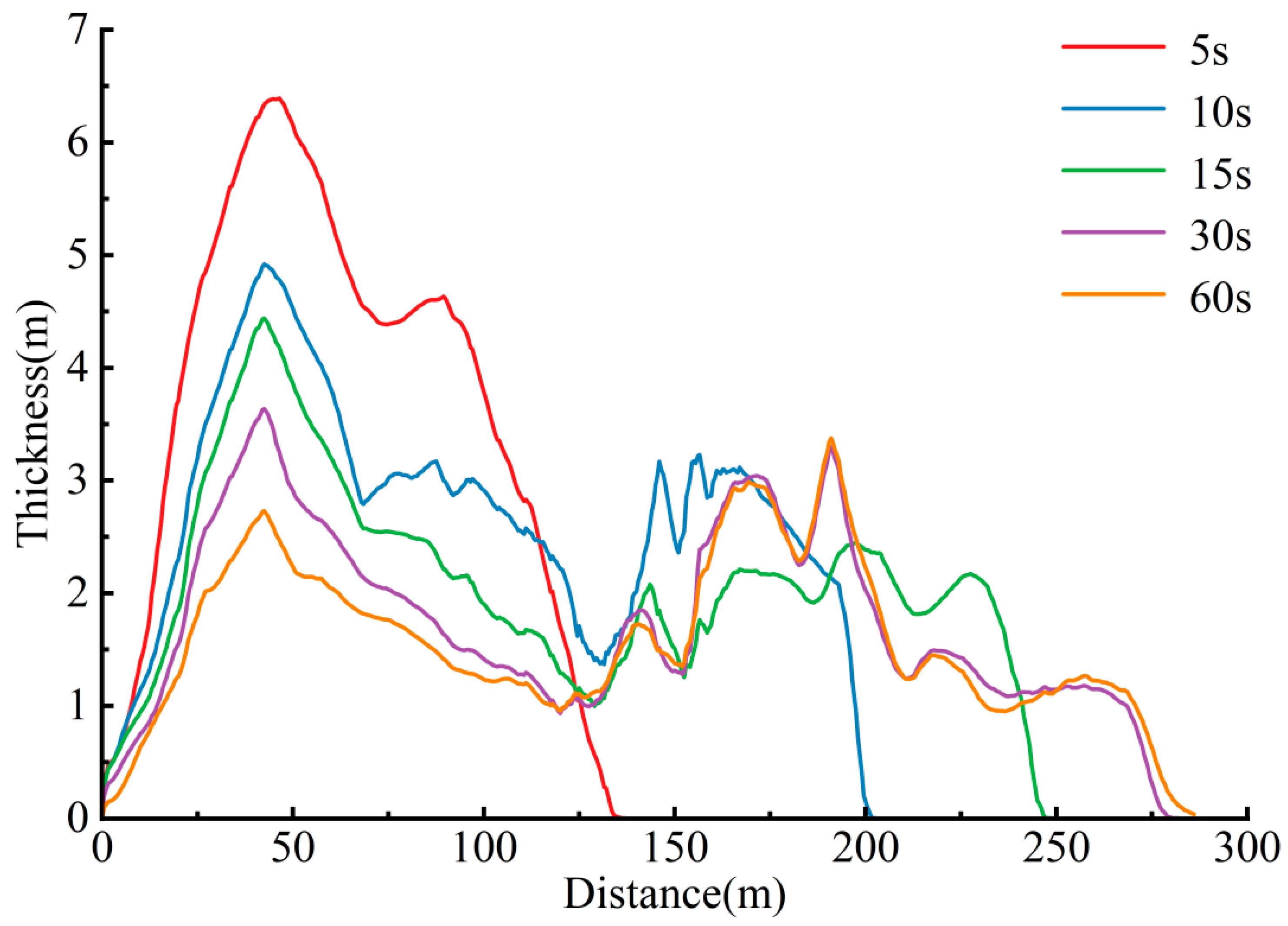
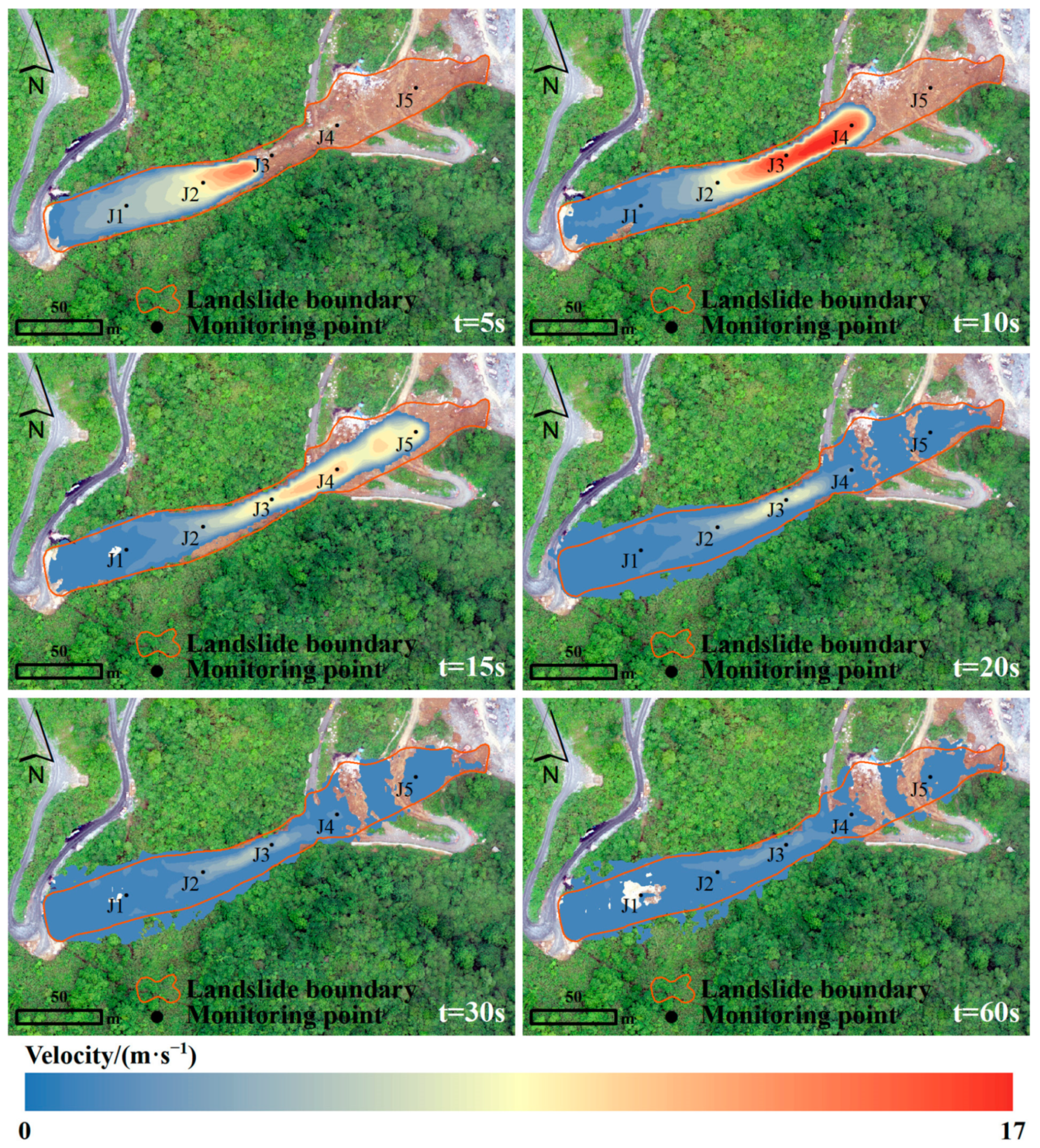
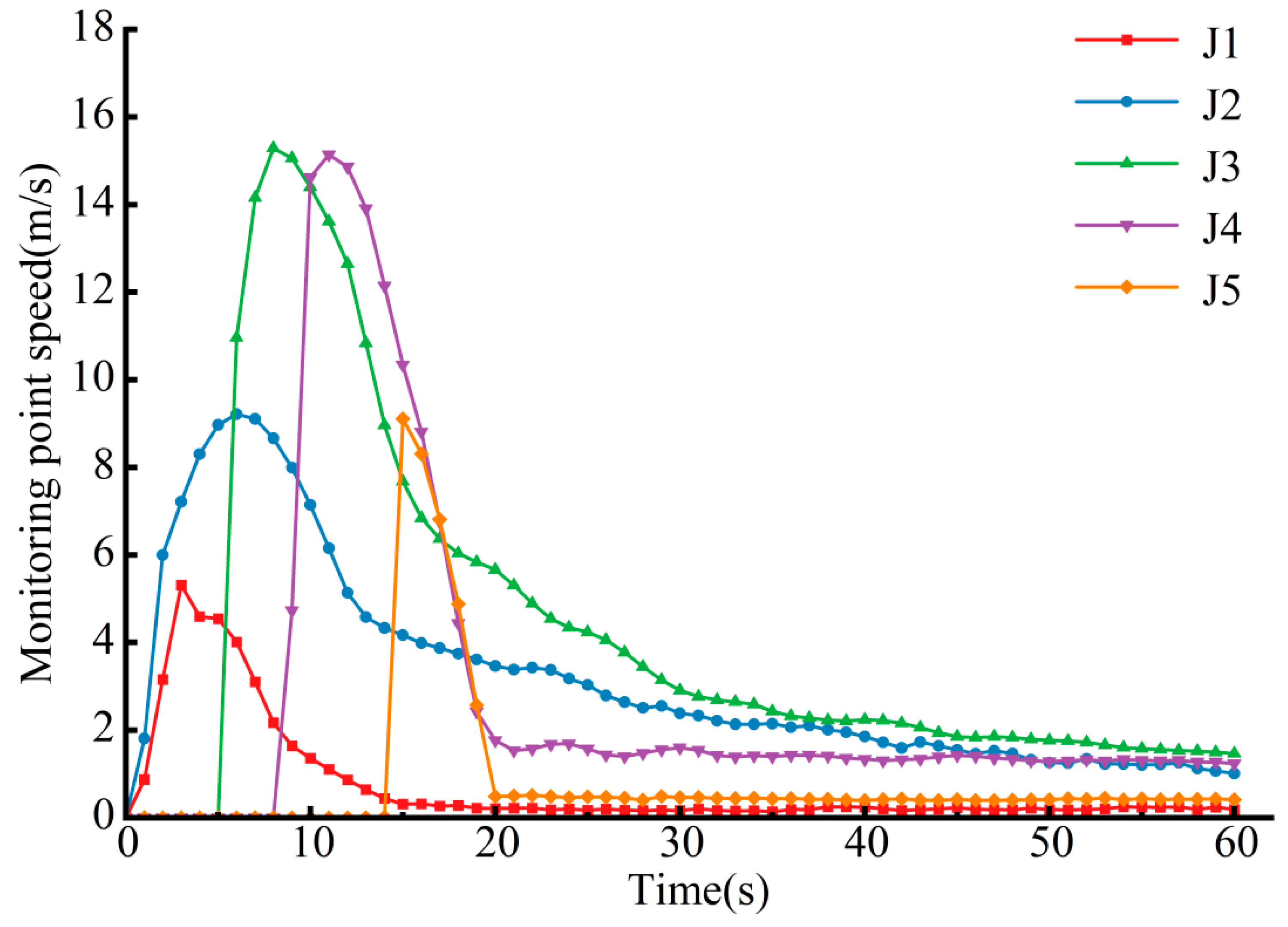
| Orbital Direction | Imaging Mode | Band | Wavelength/m | Resolution/m | Polarization Mode | Number/Scene | Processing Method |
|---|---|---|---|---|---|---|---|
| Ascending orbit | IW | C | 5.63 | 5 × 20 | VV | 22 | SBAS-InSAR |
| Parameter | Value |
|---|---|
| Density/(kg·m−3) | 2100 |
| Cohesion/kPa | 13 |
| Substrate friction coefficient | 0.36 |
| Pore water pressure coefficient | 0.53 |
| Angle of internal friction/(°) | 10.3 |
| Data Type | /m | /m2 | /m2 | /m2 | |
|---|---|---|---|---|---|
| Real landslide body | 284 | 7550 | / | 7550 | 100 |
| Simulated landslide body | 286 | 7011 | 1033 | 8044 | 79.2 |
Disclaimer/Publisher’s Note: The statements, opinions and data contained in all publications are solely those of the individual author(s) and contributor(s) and not of MDPI and/or the editor(s). MDPI and/or the editor(s) disclaim responsibility for any injury to people or property resulting from any ideas, methods, instructions or products referred to in the content. |
© 2024 by the authors. Licensee MDPI, Basel, Switzerland. This article is an open access article distributed under the terms and conditions of the Creative Commons Attribution (CC BY) license (https://creativecommons.org/licenses/by/4.0/).
Share and Cite
Cui, Y.; Qian, Z.; Xu, W.; Xu, C. A Small-Scale Landslide in 2023, Leshan, China: Basic Characteristics, Kinematic Process and Cause Analysis. Remote Sens. 2024, 16, 3324. https://doi.org/10.3390/rs16173324
Cui Y, Qian Z, Xu W, Xu C. A Small-Scale Landslide in 2023, Leshan, China: Basic Characteristics, Kinematic Process and Cause Analysis. Remote Sensing. 2024; 16(17):3324. https://doi.org/10.3390/rs16173324
Chicago/Turabian StyleCui, Yulong, Zhichong Qian, Wei Xu, and Chong Xu. 2024. "A Small-Scale Landslide in 2023, Leshan, China: Basic Characteristics, Kinematic Process and Cause Analysis" Remote Sensing 16, no. 17: 3324. https://doi.org/10.3390/rs16173324
APA StyleCui, Y., Qian, Z., Xu, W., & Xu, C. (2024). A Small-Scale Landslide in 2023, Leshan, China: Basic Characteristics, Kinematic Process and Cause Analysis. Remote Sensing, 16(17), 3324. https://doi.org/10.3390/rs16173324







